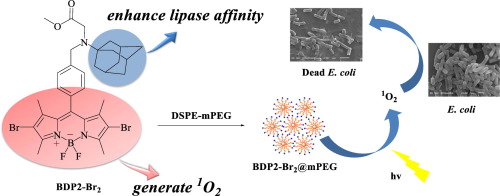Spectrochimica Acta Part A: Molecular and Biomolecular Spectroscopy ( IF 4.3 ) Pub Date : 2020-03-13 , DOI: 10.1016/j.saa.2020.118252 Jian Shao , Pu-Zhen Huang , Qiu-Yun Chen , Qing-Lin Zheng

|
The increasing number of resistant bacterial strains has raised efforts in developing alternative treatment strategies. Lipase is highly expressed in most bacteria and lipase targeting dyes will be non-sacrificed materials for a sustainable method against microorganism. The combination of chemotherapy and antimicrobial photodynamic inactivation (aPDI) method will be an effective method due to enhanced antibacterial activity. Here we reported the spectroscopic features of five boron dipyrrolylmethene (BODIPY) derivatives with different functional groups for lipase affinity and antibacterial activity. Lipase affinity tests and antibacterial assays were conducted by spectroscopic methods. Adamantane-conjugated BODIPY (BDP-2) was found to be the active compound against E. coli. Next, BDP-2 was brominated, and then assembled with PEG resulting biocompatible BDP2-Br2@mPEG nanoparticles. The MTT assay indicated that BDP2-Br2@mPEG was less toxicity on BGC-823 cancer cells without irradiation. The BDP2-Br2@mPEG can inhibit the proliferation of E. coli and damage the membrane of bacterial cell under green LED light irradiation. The results proved BDP2-Br2@mPEG can be a very promising green LED light driven antibacterial material.
中文翻译:

纳米金刚烷共轭BODIPY用于脂肪酶亲和力和光驱动抗菌
越来越多的耐药细菌菌株已经在开发替代治疗策略方面做出了努力。脂肪酶在大多数细菌中都高度表达,并且靶向脂肪酶的染料将成为不牺牲材料的一种可持续的抗微生物方法。由于增强的抗菌活性,化学疗法和抗微生物光动力学灭活(aPDI)方法的组合将是一种有效的方法。在这里,我们报道了具有不同官能团的五种双二吡咯基亚甲基(BODIPY)衍生物的光谱特征,这些脂肪基团具有脂肪酶亲和力和抗菌活性。脂肪酶亲和力测试和抗菌测定通过光谱方法进行。发现金刚烷偶联的BODIPY(BDP-2)是抗大肠杆菌的活性化合物。接下来,将BDP-2溴化,然后与PEG组装,得到生物相容性BDP2-Br 2 @mPEG纳米颗粒。MTT试验表明,BDP2-Br 2 @mPEG对未经照射的BGC-823癌细胞毒性较小。BDP2-Br 2 @mPEG可以抑制大肠埃希菌的增殖,并在绿色LED照射下破坏细菌细胞膜。结果证明BDP2-Br 2 @mPEG可以是非常有前途的绿色LED光驱动抗菌材料。











































 京公网安备 11010802027423号
京公网安备 11010802027423号